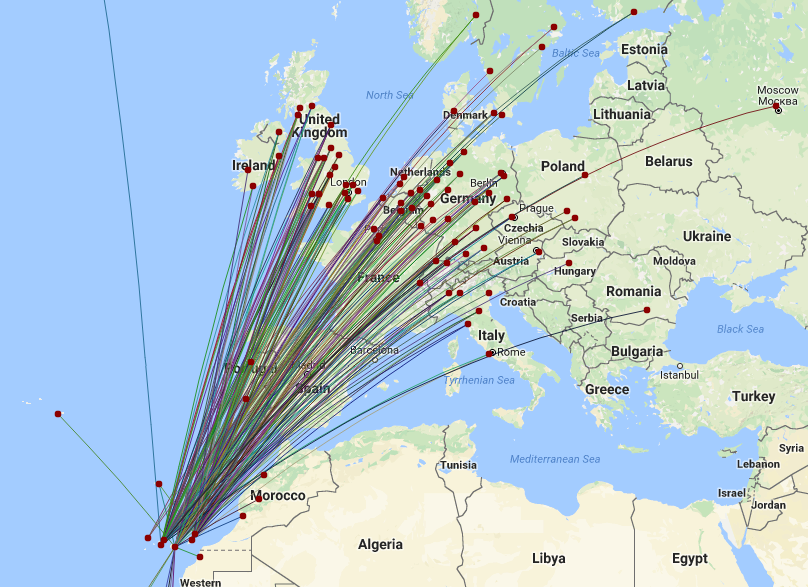The official data from the Promotur Turismo Canarias government administration shows double digit year-on-year growth across all eleven of the largest visitor source markets, with rises in 16 of the 18 largest markets - the only declines were recorded from France due to falling traffic into Fuerteventura and Lanzarote and Russia due to a fall in arrivals into Tenerife.
The rise in arrivals coincides with the first full month of the summer 2017 schedules, historically a quieter period for travel into the Canary Islands, traditionally a popular winter sun destination. As a whole, airlines are providing 10.0% more international seats into the Canary Islands compared to last year, according to data from OAG Schedules Analyser. For April 2017 alone, international arrival capacity into the Canary Islands airports was up 16.8% with almost 185,000 more one-way seats than the same month in 2016.
Among the largest foreign markets into the Canary Islands, Norway and Finland witnessed the largest rise in arrivals in April 2017 with 67.2% and 53.3% growth versus last year, but it was the United Kingdom (UK) that dominated the growing traffic with a 23.5% rise delivering almost 95,000 additional monthly passengers or 47.4% of the total growth.
It appears that currency fluctuations post Brexit have not stopped Brits from enjoying breaks in the Canary Islands and is helping to growing arrivals to record levels, accounting for around a third of all international arrivals.
International tourism arrivals into the Canary Islands had recently peaked at the start of the Century after rising beyond ten million landings between 2000 and 2002, but had been in decline across the rest of the decade, slipping to just over eight million in 2009. Buoyed by new flight options, growth has returned this decade, surpassing the ten million figure in 2011, 2012 and 2013; beyond 11 million in 2014 and 2015; and up to 13.3 million in 2016 as visitors from the UK rose to almost five million passengers (4.89 million).
 Source: OAG Schedules Analyser
Source: OAG Schedules Analyser
The OAG data shows that Ryanair, the largest international carrier in the Canary Islands has been among the main drivers of the enhanced connectivity into the archipelago, growing total capacity by 21.8% year-on-year with flights into Arrecife, Fuerteventura, Las Palmas, Tenerife. This has grown its share of inbound capacity from 15.4% in April 2016 to 16.1% in April 2017.
In fact, low-cost carriers as a total now hold a 59.1% share of the total capacity, according to the data, up from 50.1% in April 2016 offering over 760,000 inbound seats, a record for any month. Alongside Ryanair major year-on-year growth has been seen at among others easyJet, Eurowings, Monarch Airlines, Niki, Transavia, Volotea, Vueling and Wizz Air.
UK leisure carrier Jet2.com has grown its own seat-only and tour operator capacity via Jet2Holidays to become the second largest operator into the Canary Islands after adding flights from new bases at Birmingham and London Stansted and growing its offering from seven other destinations across the UK. Its capacity has risen 75.6% year-on-year between April 2016 and April 2017 and that rate is likely to grow in future months following the introduction of its first widebody jet into its fleet.
The 327-seat Airbus A330-200 has been leased from AirTanker to support its summer flight programme. It is due to enter service on May 18, 2017 out of its Manchester base, initially flying to Lanzarote, but scheduled to serve many of its popular Mediterranean hotspots such as Lanzarote, Palma de Mallorca, Rhodes and Tenerife. It will continue to operate through to the end of the summer schedule in late October 2017 and a contract has already been agreed for the A330 to return for summer 2018.
A growth in annual visitors to the Canary Islands from eight million in 2009 to nearly 13.5 million last year (up to 15 million when you also include arrivals from the Spanish mainland) has been partly facilitated by an a focus on emerging air service markets and the use of a new route incentive fund to support new air links in targeted markets. This has enabled a diversification of source markets and significant growth in arrivals from France, Italy and Poland; three markets where the Canary Islands had a very low market share and a strong potential for growth with new air connectivity.
Last month the Canary Islands launched its latest route incentive package to boost the diversity of its tourism markets and clients, calling for air services on 24 new routes supported by a Flight Development Fund (FDF) budget of €3.7 million. Alongside a notable transatlantic link between Tenerife and New York these include flights linking five Canary Island destinations with 15 European countries. This has already yielded a new route by Spanish low-cost carrier Vueling between Gran Canaria and Lyon
The FDF was approved in April 2014 after an intense period of negotiation between the Canary Islands Government and the European Commission. The result included modifications to the European Aviation Guidelines granting important exemptions to the Canary Islands due to their position as an ultra peripheral region of Europe.
The changes allow the Canary Islands to offer incentives for the start-up new air routes and grant an important concession removing the limit on the maximum number of passengers using Canarian airports. Since its inception, the Fund has incentivised the launch of 18 new routes of high interest to the Canary Islands.